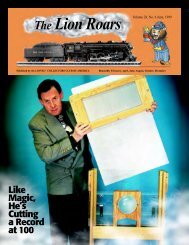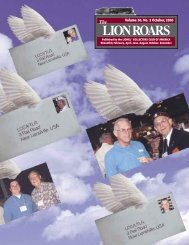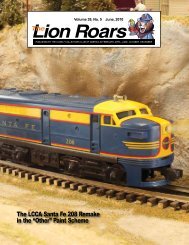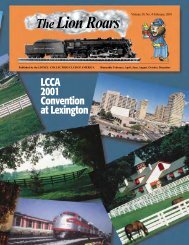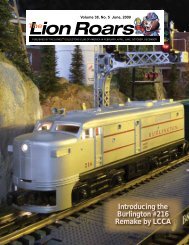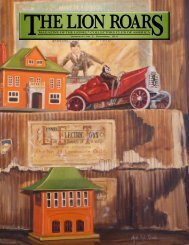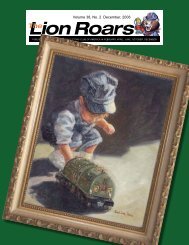HE LION ROARS - Lionel Collectors Club of America
HE LION ROARS - Lionel Collectors Club of America
HE LION ROARS - Lionel Collectors Club of America
- No tags were found...
You also want an ePaper? Increase the reach of your titles
YUMPU automatically turns print PDFs into web optimized ePapers that Google loves.
Ken MorganRM 12231The Tinplate CannonballHIGHLIGHT:“The #260Ewas the mostexpensiveO-gauge loco inthe 1930 catalog.For $21.50, youcould buy it, boththe #257 and#258 steamers,or any electricloco and getchange back.”TRIVIA: QUESTIONWhat was <strong>Lionel</strong>’s smallestO-gauge, sheet metalsteamer? Bonus question:from whom did Iborrow the initialsub-heading?Trains in TransitionAfter a few recent TPC articles about<strong>Lionel</strong>’s “modern” approach, diecastingmethods, and streamlinedlocomotives, let’s go back in timeand see what came immediately beforethat.<strong>Lionel</strong> ® didn’t produce a steamlocomotive in O gauge until 1930. In thatyear, they introduced both the biggestand the smallest electric powered,O-gauge, sheet metal steamers they evercatalogued. The biggest one was the#260E and its variants, and they are thesubjects <strong>of</strong> this installment.All about the#260E SteamerThe #260E was the most expensiveO-gauge loco in the 1930 catalog. For$21.50, you could buy it, both the #257and #258 steamers, or any electric locoand get change back. So what did youget for that? A 2-4-2 with lots <strong>of</strong> brasstrim and an eight-wheel #260T oiltender. In sets, the #260E hauled eithera #710/710/712 passenger train or four#810 series freights, including the #810derrick. Clearly, the biggest and bestrolling stock in the O-gauge line!The #260E was a heavy loco. The boilerand cab were sheet metal, but at least tomy eye, heavier than the contemporaryelectrics. The frame, cylinders, andtender body were heavy metal castings.The tender frame was sheet metal. Thecatalog picture was inaccurate – notexactly a unique occurrence – and itdidn’t do the loco justice. It was missingmuch <strong>of</strong> the brass piping.The first version <strong>of</strong> the #260E hada slightly different frame than itssuccessors. It had a groove for a creamcolored stripe. The boiler front was quitedecorative. It had brass trim around theheadlight, flag holders, and two openingsat the base, which contained a greencelluloid lens on the left, and a red oneon the right. All were lit by the sameheadlight bulb. Not exactly prototypical,but it was eye-catching! Color was alsoadded on the wheels. The spokes werered. This was a common Europeanpractice, but not typical <strong>of</strong> North<strong>America</strong>n equipment.In the following year, <strong>Lionel</strong> changed thestripe to green. Later, the casting with thegroove was replaced by one without, andthe whole frame was painted dark green.Also in 1931, <strong>Lionel</strong> placed a switch inthe cab so that the pendulum reverse unitcould be turned <strong>of</strong>f. This enabled the locoto be used with the automatic stop stationaccessory. The loco had to be locked int<strong>of</strong>orward. Otherwise, when the stationsaid “go” the loco would be in reverse.That would cause obvious distress to theoperator, not to mention the probability<strong>of</strong> derailed cars given the couplers thenin use.The loco was also equipped with “fireboxglow” – a red or amber bulb under thecab. In 1933, the “chugger” was added.One needed an active imagination tobelieve it sounded like a real steamengine, but at least it provided soundeffects.These features appeared in severalStandard gauge locos, but not in any othersheet metal, O-gauge steamers. Most <strong>of</strong>what I have found in print indicated thatthis was the year that the tender went tothe 12-wheel version. Interestingly, therewas no change in number, which was not<strong>Lionel</strong>’s normal practice. This loco isshown in photo 1. Note that the #260Tnever had a whistle. There is no room forone in the cast body. Maybe that helpsPhoto 1The Lion Roars 29




